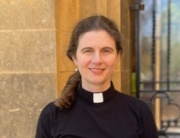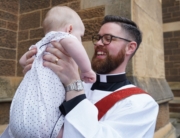Preacher: The Rev’d Dr Lynn Arnold AO, Assistant Priest
“Is (Father) Christmas dead? Have the scoffers won?”
May the words of my mouth and the meditations of our hearts be acceptable in your sight, O Lord, our Rock and our Redeemer. Amen.
As you heard the readings tonight, did any phrases or words stand out to you? Were you able to discern any recurring theme? Well I did and frankly it was a little disturbing on this second Sunday of Advent – the Peace Sunday. Here are just some that jumped out at me:
But the Lord is righteous … (the wicked) shall be confounded and turned backward: all those who hate Zion. [Psalm 129]
O that you would tear open the heavens and come down, so that the mountains would quake at your presence … to make your name known to your adversaries, so that the nations might tremble at our presence! [Isaiah 63-64]
And:
But by the same word the present heavens and earth have been reserved for fire, being kept until the day of judgment and destruction of the godless. [2 Peter 3]
And if we didn’t get enough apocalyptic messaging from those readings, then our first hymn, the Office Hymn gave us these words:
Rise, God, judge thou the earth in might, this wicked earth redress.
So, not much doubt about the message – watch out, God is coming and our enemies are for it. Then an added phrase stood out for me from the Epistle reading:
In the last days scoffers will come, scoffing and indulging their own lusts and saying, ‘Where is the promise of his coming? For ever since our ancestors died, all things continue as they were from the beginning of Creation!”
Thus the perceived arrogance of our adversaries will just compound their come-uppance. And, in our contemporary world, whether these be the last days or not, there are certainly many about who ask the question ‘Where is the promise of his coming?.’ Just considering the theme of Christmas, there are plenty of scoffers in our midst. Yesterday it was reported that the Norwegian newspaper, Aftenpost, carried a death notice a couple of days ago that, in translation, read:
Our dear Father Christmas, born 12 December 1788 … died on 3 December in Nordkapp
The announcement, which was said to have come from “the whole world” gave notice that a funeral would be held at the North Pole Chapel on 28 December. No cause of death was given. While in another part of the world, the government of President Islam Karimov of Uzbekistan announced that their version of Santa Claus, Father Frost was out, to be excluded from state media – because it was a cultural imposition from the west.
And we don’t need to go globe-trotting for such stories. On November 26, the biggest Christmas tree in south-west Sydney was fire-bombed. And, just days ago, in Victoria, a Ministerial directive gave a secularly safe memo re such things as carols in schools. The following report about the directive appeared in the Age:
“A secular education is not devoid of everything that has a spiritual element,” the advice says. It then goes on to say that a mandala, an important part of Tibetan Buddhism, can be used in maths to learn about shapes and symmetry, and in art. Schools can also put up Christmas decorations and display a Menorah because these items have “a secular cultural place in Australian society”. But they are not allowed to display religious material.
And, it was reported, the directive also banned hymns, though carols were okay. One suspects that a school, seeking to be safely within the directive’s bounds, would include “Rudolph the Red Nose Reindeer”, “Have yourself a Merry Little Christmas” and “Deck the Halls with Boughs of Holly” as their chosen carols in preference to “O Holy Night” and “O Come all Ye Faithful”.
This is all very disturbing. Has political correctness gone mad? Are the faith barbarians at the gates and breaking through?
As these questions rumble in my mind, I look at the Advent wreath before me. The second candle has been lit today. The second candle, the Peace Candle, is also known as the Bethlehem Candle, because of Jesus’ birth there. So this second candle complements the first candle, last week’s candle of hope. The message of the Advent candles builds, week by week, until the final candle of Christmas Day is that of the incarnation of God, the birth of the baby Jesus.
The time of Jesus’ birth was one of enormous political upheaval and religious anxiety. We know that the geo-political tensions of the Middle East around that time were playing out in terms of religious anxiety by the amount of writing produced of the Apocalyptic Genre. Our Bible contains a number of books that are apocalyptic – most notably Daniel and Revelation. But at that time there were many more works written that are largely unknown by the wider faith community today – Books such as the Apocalypses of James, Paul, Peter, Stephen and Thomas amongst many others. These works found ready audiences amongst a people seeking solutions to existential dilemmas.
Today we read this apocalyptic literature through the lens of our circumstance; and therefore tend to focus on their overt messages of repentance and righteousness – or else! But at the time they were written, such works were seen equally as much as powerful messages of hope for oppressed believers. They were affirmations that, no matter how bad circumstances seemed to be, that the faithful could remain assured that God not only would not but could not be defeated. All such literature does see God wreaking vengeance upon the unfaithful, but the books of such literature also always end well for the faithful.
So now, let’s come to our own times. We see an enormous amount happening in our world that worries us. The institutions and practices of our faith seem under assault from all sides – from the secular world with its band of fundamentalist atheists, to threats from extremists of other religions. All these assailants scoff at our faith and revile our practices and institutions. How do we respond to such assaults? How do you respond when you read press articles about the secularising of the Christ Mass into Happy Holiday in the wider community, or in our schools in particular?
Returning to the time of Jesus, one might have thought that his birth and his teachings whilst he lived amongst us, would have been enough for those who proclaimed themselves as his followers to see the certain hope that was held out. But even then, there were followers who could not find within themselves the depth of faith to understand the message that Jesus brought. Many of his followers wanted the Terminator aspect of apocalyptic literature to be played out; and were disappointed when Jesus did not call in legions of angels to save him and smote his and their persecutors. Such half-hearted followers soon fell away. They returned to what they felt were more secure responses to their religious anxieties. Creating false gods of wrath, they turned away from a God of Hope.
There is a verse, well known I am sure to all of us, that puts the birth of Jesus into context given the apocalyptic feeling of theatage:
And after the earthquake a fire; but the LORD was not in the fire: and after the fire a still small voice. 1 Kings 19:12
The religious anxieties of the first century AD were awaiting the Lord’s fire and earthquake; but what they received was a still small voice – a baby’s cry.
A moment ago we sang that beautiful hymn, “Come, thou long-expected Jesus”. Not only are its words beautiful; they are also counter-poised against the sentiments from our other readings that I identified earlier. Hear these words for example:
From our fears and sins, release us,
Let us find our rest in thee
And:
Now thy gracious kingdom bring.
And in a moment we will hear the choir sing the Anthem, “O thou the central Orb”. I ask you to listen for these beautiful references to a different approach by God to the travails of this world:
Come, quickly come, and let thy glory shine,
Gilding our darksome heaven with rays Divine.
And:
Let Thy bright beams disperse the gloom of sin,
Our nature all shall feel eternal day.
Hindsight is so easy; we can look back on the time of Jesus and see how mistaken many were when they failed to hear the still small voice in their desire for the earthquake and fire of the Lord. But what of our own time, when we feel religious anxieties from the threats around us? Are we really seeking the Christ Mass of the Prince of Peace – the voice that started with a baby’s cry? Or are we wishing for a Christ Massacre by a Lord of earthquake and fire? Upon what foundation is our faith built from which we seek to respond to the religious anxieties of our time?
In 1898, the poet C P Cavafy wrote a poem “Waiting for the Barbarians”. Themed upon the latter days of the Western Roman Empire, when barbarian invasions were a constant threat, Cavafy wrote about the emotions and reactions of those awaiting attack. The setting is one of hopelessness by both the wider populace and the rulers themselves:
Why isn’t anything happening in the senate?
Why do the senators sit there without legislating?
Because the barbarians are coming today.
What laws can the senators make now?
Once the barbarians are here, they’ll do the legislating.
But there is a twist in the tail of the poem. Suddenly the populace face a new dismay from an unexpected circumstance:
Why this sudden restlessness, this confusion?
(How serious people’s faces have become.)
Why are the streets and squares emptying so rapidly,
everyone going home so lost in thought?
And why this sudden despondency? And what was the unexpected outcome?:
Because night has fallen and the barbarians have not come.
And some who have just returned from the border say
there are no barbarians any longer.
That is the poetic sting in the tail of the poem; but its real power lay in its philosophic sting, for the poem ends:
And now, what’s going to happen to us without barbarians?
They were, those people, a kind of solution.
The good citizens and senators of the poem’s setting had suddenly found themselves confronted by their own lack of belief. Their identity was found to have been defined not by something intrinsic but by something extrinsic. The threat from outside gave meaning to their identity and their faith; and once the threat evaporated, they found themselves with nothing.
On this Second Sunday of Advent, as we confront a very uncertain world, how will our faith respond? Will we confront the uncertainty on its terms? Or will we confront it upon the absolute certainty in our God, in his invincibility and in his compassion for his creation?
The proof of his compassion is what is proved to us each year at Christmas time – God’s coming into the world to reach out to us. And then, later in the church calendar, the proof of his invincibility will be celebrated on Easter morn.
If we can’t accept these proofs, then maybe the problem is not others who scoff our faith, but we ourselves who scoff its power by not truly believing it.





